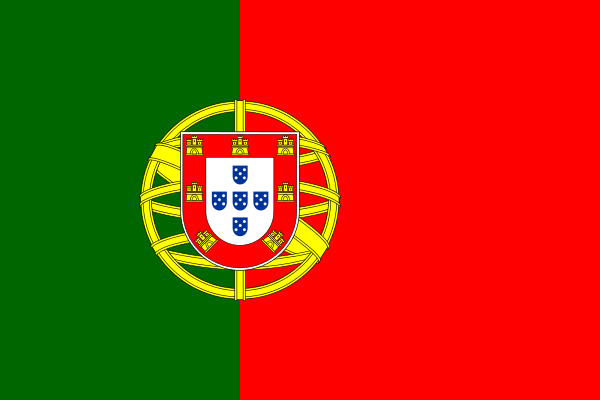Colors:
Green: The verdant hue within the flag holds a profound connection with the hopes and dreams of the Portuguese populace. It visually embodies the sprawling landscapes, fecund fields, and innate beauty of the nation's terrain. This shade serves as a tribute to the nation's agrarian abundance and underlines the vital role of the environment.
Red: The crimson tone carries within it the weighty symbolism of the sacrifices rendered by those who valiantly fought for Portugal's sovereignty and emancipation over the course of its historical trajectory. It stands as a poignant reminder of the valorous endeavors of countless individuals who engaged in battles, conflicts, and revolutions.
Field:
The flag's design ingeniously weaves together two vertical bands in a manner that resonates with profound impact. On one side, the broader emerald green band occupies approximately two-thirds of the flag's expanse, while the other side features a narrower, yet equally significant, ruby-red band spanning the remaining third. Coat of Arms:
Crown: Atop the emblematic composition gracing the flag rests a resplendent golden mural crown. This majestic crown, adorned with five prominently visible towers, stands as an unequivocal representation of Portugal's independent and sovereign stature. The quintet of towers evokes the aura of regal supremacy and authority.
Escutcheon (Shield):
Five Blue Escutcheons: Skillfully arrayed in the configuration of the Cross of the Order of Christ, these five azure escutcheons chronicle the triumphs of Afonso I against five Moorish kings during the foundation of Portugal as a sovereign realm. This particular facet underscores the nation's Christian heritage, emphasizing the ascendancy of Christianity over the Moors.
Gold Border with Castles and Lions: Encircling the core of the escutcheon, a tapestry of golden castles intermingles with smaller argent shields bedecked in blue stripes and silver dots. The castles, in their architectural splendor, symbolize the reclamation of fortified cities from the Moors during the historic Reconquista. The silver shields with azure adornments, known as "bezants," establish a connection to Portugal's intricate involvement in the Crusades and its significance within the Christian sphere.
Armillary Sphere: Commanding the center stage of the escutcheon, the armillary sphere serves as an emblematic representation of Portugal's illustrious Age of Discovery. A testament to the nation's mastery of navigation and maritime exploits, the sphere resonates with allusions to pioneering exploration, maritime excellence, and substantial contributions to scientific advancement.
Meaning and Symbolism:
The flag of Portugal serves as an evocative visual chronicle of the nation's historical odyssey, its indomitable resilience, and its manifold achievements. It encapsulates the trials and triumphs of the Portuguese people as they pursued ideals of freedom, territorial expansion, and cultural identity.
The intricate detailing of the coat of arms mirrors Portugal's profound role as a trailblazer in maritime exploration during the Age of Discovery. It serves as an emblematic tribute to the nation's navigational prowess, its invaluable contributions to scientific inquiry, and its far-reaching discoveries.
In summation, the flag stands as a potent and profound emblem, effectively conveying Portugal's opulent heritage, its dynamic historical tapestry, and its unwavering spirit of exploratory zeal and conquest, all while reverently acknowledging its Christian origins and the unwavering sacrifices of its citizenry.
Last Updated on: November 13, 2025
